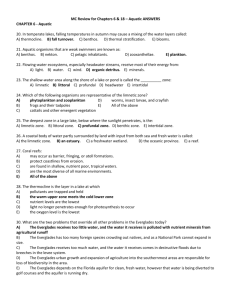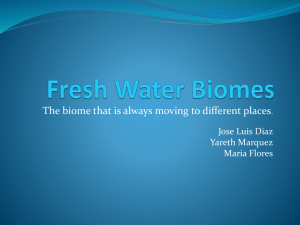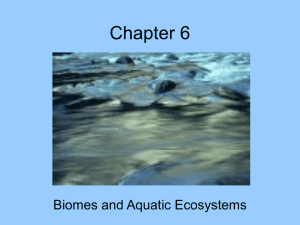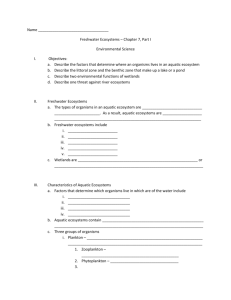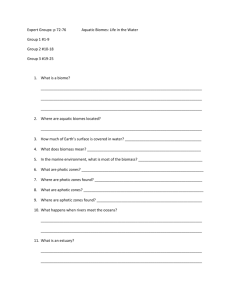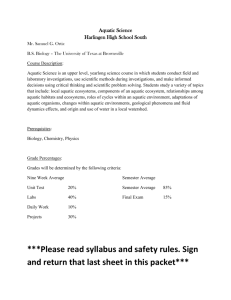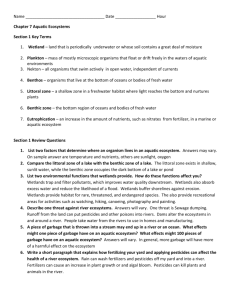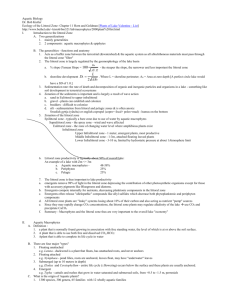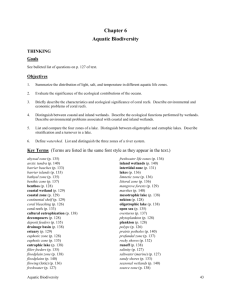AQUATIC ECOLOGY QUIZ
advertisement
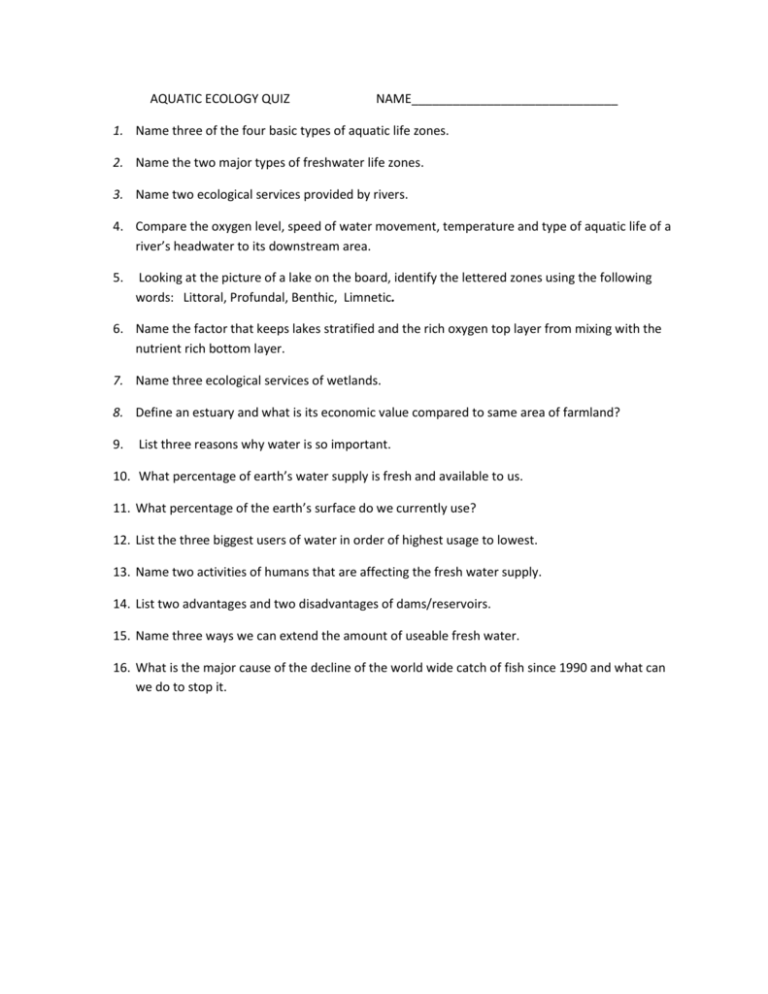
AQUATIC ECOLOGY QUIZ NAME______________________________ 1. Name three of the four basic types of aquatic life zones. 2. Name the two major types of freshwater life zones. 3. Name two ecological services provided by rivers. 4. Compare the oxygen level, speed of water movement, temperature and type of aquatic life of a river’s headwater to its downstream area. 5. Looking at the picture of a lake on the board, identify the lettered zones using the following words: Littoral, Profundal, Benthic, Limnetic. 6. Name the factor that keeps lakes stratified and the rich oxygen top layer from mixing with the nutrient rich bottom layer. 7. Name three ecological services of wetlands. 8. Define an estuary and what is its economic value compared to same area of farmland? 9. List three reasons why water is so important. 10. What percentage of earth’s water supply is fresh and available to us. 11. What percentage of the earth’s surface do we currently use? 12. List the three biggest users of water in order of highest usage to lowest. 13. Name two activities of humans that are affecting the fresh water supply. 14. List two advantages and two disadvantages of dams/reservoirs. 15. Name three ways we can extend the amount of useable fresh water. 16. What is the major cause of the decline of the world wide catch of fish since 1990 and what can we do to stop it. AQUATIC ECOLOGY QUIZ KEY 1. Name 3 Plankton, free-floating biota. Necton: swimmers; Benthos: bottom dwellers (barnacles, oysters) and Decomposers: breakdown organic compounds (mostly bacteria). 2. Name 2 Standing (lentic) water such as lakes, ponds, inland wetlands; Flowing (lotic) systems such as streams and rivers. 3. Name 2 Deliver nutrients to sea to help sustain coastal fisheries; Deposit silt that maintains deltas; Purify water; Renew and renourish wetlands; Provide habitats for wildlife. 4. Upstream more oxygen, faster moving, colder temp, less algae and bacteria then downstream. 5. Looking at the picture of a lake on the board, identify the lettered zones using the following words: Littoral, Profundal, Benthic, Limnetic. Littoral zone (near shore, shallow, with rooted plants). Limnetic zone (open, offshore area, sunlit). Profundal zone (deep, open water, too dark for photosynthesis). Benthic zone (bottom of lake, nourished by dead matter). 6. Temperature 7. Need three. Filter and degrade pollutants; Reduce flooding and erosion; Help replenish stream flows during dry periods; Help recharge ground aquifers; Provide economic resources and recreation. 8. Estuary; economic value compared to same area of farmland? Partly enclosed area of coastal water mixing with fresh water; 83K compared to 1800. 9. List three. Water keeps us alive, moderates climate, sculpts the land, removes and dilutes wastes and pollutants 10. 0.02% 11. 1/2 12. List three in order of highest usage to lowest. Irrigation is the biggest user of water (70%), followed by industries (20%) and cities and residences (10%). 13. Name two. Overdrawing ground water, pollution, and overbuilding so aquifers can’t replinsh. 14. List two advantages and two disadvantages. Advantages: water for irrigation, drinking, recreation, electricity, flood control; Disadvantates: Flooded land destroys forests or cropland and displaces people; Large losses of water through evaporation, Downstream cropland and estuaries are deprived of nutrient-rich silt; Risk of failure and devastating downstream flooding; Migration and spawning of some fish are disrupted 15. Name three. Conservation, improve irriagation so less loss; recycle water, conserve at home; fix leaks 16. Major cause of the decline; stop it. Overfishing – reduce amount of fish that can be caught and ban certain techniques such as long line, purse seine, dredging

